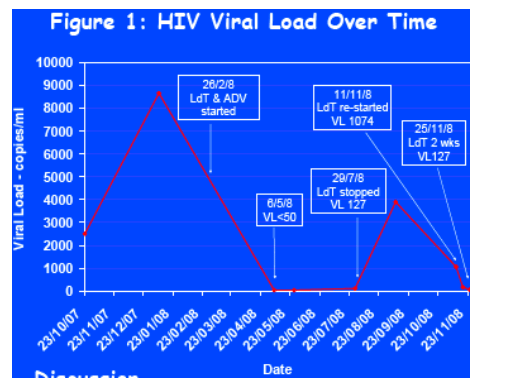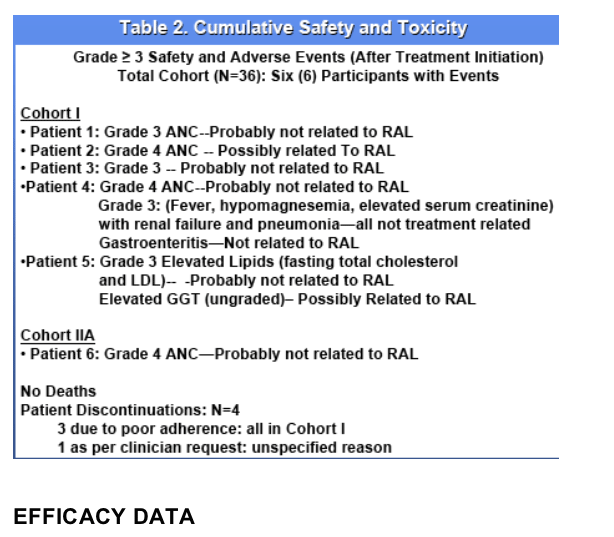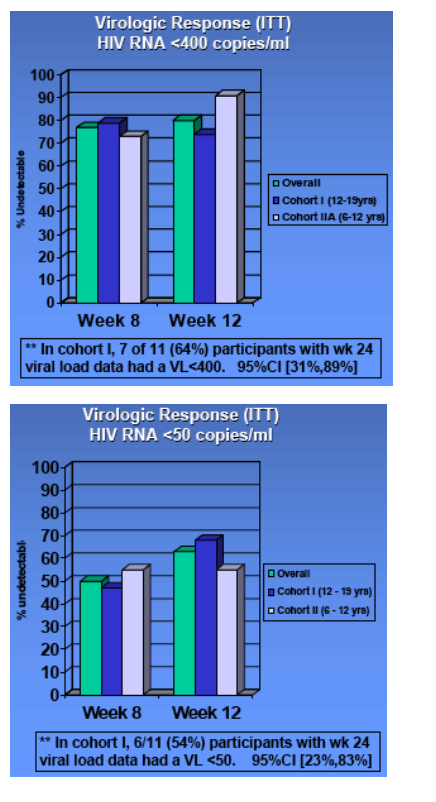 |
 |
 |
| |
Safety and Efficacy of Raltegravir (RAL) in Pediatric HIV Infection. Preliminary Analysis From IMPAACT P1066
|
| |
| |
Reported by Jules Levin
CROI 2009 Feb 8-12 Montreal
Andrew Wiznia1, Pearl Samson2, Edward Acosta3, Hedy Teppler4, Elizabeth Sheeran5, Bobbie Graham6, Terry Fenton2, Edward Handelsman7, Carol Worrel8, Sharon Nachman9 for the IMPAACT P1066 Team
1Jacobi Medical Center, Bronx, NY, USA, 2Harvard School of Public Health, Boston, MA, USA, 3Univ. of Alabama at Birmingham, AL, USA, 4Merck Research Labs, North Wales, PA, USA, 5Social and
Scientific Systems, Silver Springs, MD,USA, 6Frontier Science, Inc., NY, USA, 7NIAID, Bethesda, MD, USA, 8NICHD, Bethesda, MD, USA, Boston, MA, USA 9SUNY at Stony Brook, NY, USA
AUTHOR CONCLUSIONS
RAL in 6-18 yr old HIV infected children was generally well tolerated.
Preliminary data at 8 and 12 weeks shows viral suppression in a majority of participants:
-- 8 weeks: 50% <50 copies/ml; 77% <400 copies/ml
-- 12 weeks: 63% <50 copies/ml; 80% <400 copies/ml
-- CD4 increases for cohort I
Monitoring of safety and efficacy is continuing.
For Cohort IIA (ages >6-12 yrs), repeat PK and safety evaluations, at a uniform dose of 400 mg PO BID, regardless of weight, is ongoing.
ABSTRACT
Raltegravir (RAL) is a potent and selective HIV-1 integrase inhibitor approved for use in adults. IMPAACT P1066, the first RAL pediatric trial, is an ongoing prospective, non-randomized, open label, dose finding trial of RAL plus optimized background regimen (OBR) in treatment experienced children.
Methods: Children ages >12 to <19 (Cohort I) and >6 to <12 (Cohort IIA) have enrolled, sequentially older to younger. In Stage 1, RAL poloxamer film tablets were added to a stable, failing ARV regimen; pharmacokinetics was done on day 7-12 and then OBR started. Clinical and lab safety and efficacy evaluations were routinely performed.
Results: 36 patients have accrued: 22 in Cohort 1 and 14 in Cohort IIA. Participants were initially treated at 6 or 8 mg/kg/dose BID with a maximum dose of 600 mg BID; Cohort IIA received 8 mg/kg BID. 47% were male, 67% were black and 25% white. Median baseline HIV-1 RNA was 4.44 log10 copies/ml (range: 3.09-5.95) and were similar between the two cohorts. Median baseline CD4% was 22 (0-42%). Six participants had >grade 3 adverse event: 5 neutropenia, 1 increased lipids, 1 increased creatinine associated with aminoglycoside use; one grade 4 neutropenia and one elevated GGT were judged to be possibly related to RAL. There were no deaths; there were 4 withdrawals; 3 were due to poor adherence (Cohort I) and one per physician request (Cohort IIA). In an intent-to-treat analysis of those treated at 8 mg/kg and scheduled to reach week 8 or 12 prior to 12/1/08 and were off-treatment was considered a failure. HIV RNA <400 copies/ml was achieved in 23/30 (77%) and 24/30 (80%) at weeks 8 and 12, respectively. Median CD4% was 25% and 27% at weeks 8 and 12, respectively.
Conclusions: Preliminary, short term and partial data from IMPAACT P1066 suggests that RAL plus OBT in children ages 6-18 was generally safe, well tolerated and effective. Enrollment into these cohorts, as well as use of a chewable formulation for children <12 years of age, is continuing.
BACKGROUND
There is an acute need for potent antiretroviral therapy for HIVinfected youth failing current therapy due to resistance, toxicities, or drug intolerance.
RAL is a potent and selective HIV-1 integrase inhibitor which is well tolerated and has demonstrated potent HIV-1 suppression in treatment naïve and experienced HIV-infected adults [1,2,3]
Preliminary pharmacokinetic results from Cohort I, ages >12 to <19 yrs have previously been reported. 4,5 Based upon fasting PK parameters, a dose of 400 mg BID, administered with or without food, was chosen for cohort I, Stage II.
Initial dose for Cohort IIA, ages >6 to <12 yrs, was 8 mg/kg; results presented here. Additional Stage I intensive PK and safety data at a uniform dose of 400 mg BID is ongoing. Stage II dose not yet selected.
Cohort IIB, ages >6 to <12 yrs of age, will receive a chewable formulation (data not yet available).
METHODS
P1066 is a Phase I/II multicenter, open label, non-comparative, dose finding, safety and efficacy trial of RAL plus optimized background regimen in treatment experienced, HIV-infected children with HIV RNA VL > 1000 copies.
Here we report preliminary safety and efficacy data in 22 Cohort I and 14 Cohort IIA participants, all receiving the raltegravir poloxamer formulation.
Stage I (dose finding) for first 10/cohort had RAL added to stable, failing ARV regimen and regimen optimized after intensive PK visit between days 5-12.
For Stage II (no PKs), RAL and regimen optimization started simultaneously.
Safety Data: Cumulative clinical and laboratory data presented with cut off
date of 12/1/08.
Efficacy Data: Week 8 and 12 HIV RNA time points presented.
-- HIV RNA Assay: Roche 1.5 Ultrasensitive assay
-- Analysis: Intent to Treat (ITT): "SUCCESS" defined as RNA <400 and on-study raltegravir at time point. Participants taken off therapy before specified time point were considered "FAILURES" at that time point.




References:
[1] Steigbigel RT, et al. Raltegravir with optimized background therapy for resistant HIV-1 infection. N Engl J Med 2008; 359:339-354.
[2] Cooper, DA, et al. Subgroup and resistance Analyses of raltegravir for resistant HIV-1 infection. N Engl J Med 2008: 359: 355-365.
[3] Markowitz M. et al. Sustained antiretroviral efficacy of raltegravir as part of combination ART in treatment-naive HIV-1 infected patients: 96 weeks. XV
II International AIDS Conference; 2008 Aug 3-8. Mexico City, Mexico, 2008.
[4] Acosta E, et al. Abstract P8. 9th International Workshop on Clinical Pharmacology of HIV Therapy, April 7-9, 2008, New Orleans, LA.
[5] Nachman, S., et al. Raltegravir (RAL) pharmacokinetics and safety in adolescents: preliminary results from IMPAACT P1066
[ Poster]. ICAAC/IDSA Annual Joint Meeting 2008; 2008 Oct 25-28, Washington, D.C., 2008.
|
| |
|
 |
 |
|
|